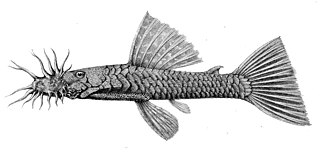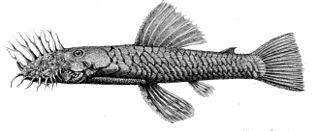Ancistrus hoplogenys is a species of armored catfish native to Argentina, Brazil, Guyana, Paraguay, Peru, and Uruguay, where it occurs in the basins of the Amazon River, the Essequibo River, and the Paraguay River. It has also been reported from Suriname. This species grows to a length of 15.8 centimetres (6.2 in) SL. In the aquarium hobby, this fish is sometimes known as the spotted or starlight bristlenose pleco, although it may also be referred to by its L-number, which is L059.

Ancistrus caucanus is a species of catfish in the family Loricariidae. It is native to South America, where it was at one point thought to occur in the Cauca River basin in Colombia, for which it is named, although subsequent research suggested in 2013 that it is actually native to the Magdalena River basin, whereas its congener Ancistrus vericaucanus is the species native to the Cauca. The species reaches 5.2 cm SL. It is not to be confused with the similarly named species Lasiancistrus caucanus.
Ancistrus galani is a species of catfish in the family Loricariidae. It is native to South America, where it occurs only in Los Laureles Cave, at an elevation of 650 m (2133 ft) above sea level, in the Socuy River basin, which is part of the Lake Maracaibo drainage system in the state of Zulia in Venezuela. The species reaches 5.6 cm SL and was named after Carlos Galan, a Venezuelan speleologist. A. galani differs from most Ancistrus species in having an unpigmented body, atrophied or entirely absent eyes, and highly reduced ocular orbits, which are all thought to be adaptations to its dark subterranean habitat and stygobitic lifestyle.
Ancistrus bolivianus is a species of catfish in the family Loricariidae. It is native to South America, where it occurs in the basins of the Beni River, the Mamoré River, and the Madre de Dios River. The species reaches 8.8 cm SL.
Ancistrus jelskii is a species of catfish in the family Loricariidae. It is native to the upper Tulumayo River basin, which is part of the Ucayali River system in Peru. The species reaches 8 cm in total length.
Ancistrus gymnorhynchus is a species of catfish in the family Loricariidae. It is a freshwater species native to South America, where it occurs in the upper Pao River basin in the Orinoco drainage, as well as in coastal rivers of the states of Carabobo and Yaracuy in Venezuela. The species reaches 14.2 cm SL and it is known to feed on algae, which it has been noted to be very efficient at removing.

Ancistrus triradiatus is a species of catfish in the family Loricariidae. It is native to South America, where it is known from the drainage basins of the Orinoco, the Los Guayos River, Lake Valencia, and Lake Maracaibo. The species reaches 9.2 cm SL. It sometimes appears in the aquarium trade, where it is known as the gold-spot or three-ray bristlenose pleco.
Ancistrus formoso is a species of catfish in the family Loricariidae. It is native to South America, where it occurs only in the cave of Buraco do Ducho in the Formoso phreatic system in Brazil. It is a stygobitic species that is known to lack eyes and body pigmentation, which indicate a high level of specialization to living in a subterranean, lightless environment. It is one of three known stygobitic members of Ancistrus, alongside A. cryptophthalmus and A. galani. The species reaches 7.9 cm SL.
Ancistrus latifrons is a species of catfish in the family Loricariidae. It is native to South America, where it occurs in the basins of the Amazon River and the Solimões River. The species reaches 15.4 cm SL.
Ancistrus lithurgicus is a species of catfish in the family Loricariidae. It is a freshwater species native to South America, where it occurs in the basin of the Essequibo River in Guyana. The species reaches 13.2 cm SL.

Ancistrus multispinis is a species of catfish in the family Loricariidae. It is native to South America, where it occurs in the Atlantic coastal drainage of eastern Brazil, ranging from the Macacu River to the Maquiné River. The species reaches 14.2 cm SL. The species has nocturnal habits and has been used in studies on the impacts of deltamethrin on fish blood in Brazil.
Ancistrus erinaceus is a species of catfish in the family Loricariidae. It is native to South America, where it is reportedly known from Chile. The species reaches 7.5 cm SL.
Ancistrus nudiceps is a species of catfish in the family Loricariidae. It is native to South America, where it occurs in the Takutu River basin in the upper Branco River drainage in Guyana. The species reaches 7.9 cm SL.

Ancistrus occidentalis is a species of catfish in the family Loricariidae. It is native to South America, where it occurs in the Bobonaza River basin in Ecuador. The species reaches 8.6 cm SL.
Ancistrus variolus is a species of catfish in the family Loricariidae. It is native to South America, where it occurs in the Ampiyacu River basin in Peru. The species reaches 4.8 cm SL.

Ancistrus montanus is a species of catfish in the family Loricariidae. It is native to South America, where it occurs in high-altitude freshwater environments, with the type specimen being collected from an elevation of around 457 m, in the Beni River basin in the upper Madeira River drainage in Bolivia. The species reaches 9.2 cm SL.
Ancistrus bufonius is a species of catfish in the family Loricariidae. It is native to South America, where it occurs in the Apurímac River basin in Peru. The species reaches 11.5 cm SL.
Ancistrus malacops is a species of catfish in the family Loricariidae. It is a freshwater fish native to South America, where it occurs in the Ampiyacu River basin in Peru. FishBase states that the species reaches 7.7 cm SL, although larger specimens, including one of 11.78 cm SL from the Gustavo Orcés V. Natural History Museum in Quito, Ecuador, are known.
Ancistrus mattogrossensis is a species of catfish in the family Loricariidae. It is a freshwater species native to South America, where it is known only from Brazil.
Ancistrus trinitatis is a dubious species of catfish in the family Loricariidae. It is known only from the Caribbean, where it occurs in freshwater environments on the island of Trinidad in Trinidad and Tobago. This species is of uncertain validity, as Theodore Gill referred to the type material in 1858 as Ancistrus guacharote and it was later described by Albert Günther in 1864 as Chaetostomus trinitatis, but neither description is considered sufficient to determine the validity and identity of the taxon. While the original locality of the type material was listed as Puerto Rico, this was determined to be in error and the material was determined to have actually originated from the Maracaibo Basin of Venezuela. In 1946, Henry Weed Fowler described the species Ancistrus maracasae from Trinidad, and in 2019, Lesley S. De Souza, Donald C. Taphorn, and Jonathan W. Armbruster determined that A. maracasae and A. trinitatis are synonymous, designating the holotype of A. maracasae as the neotype of A. trinitatis, although sources such as FishBase and ITIS list the two species as valid but separate.




